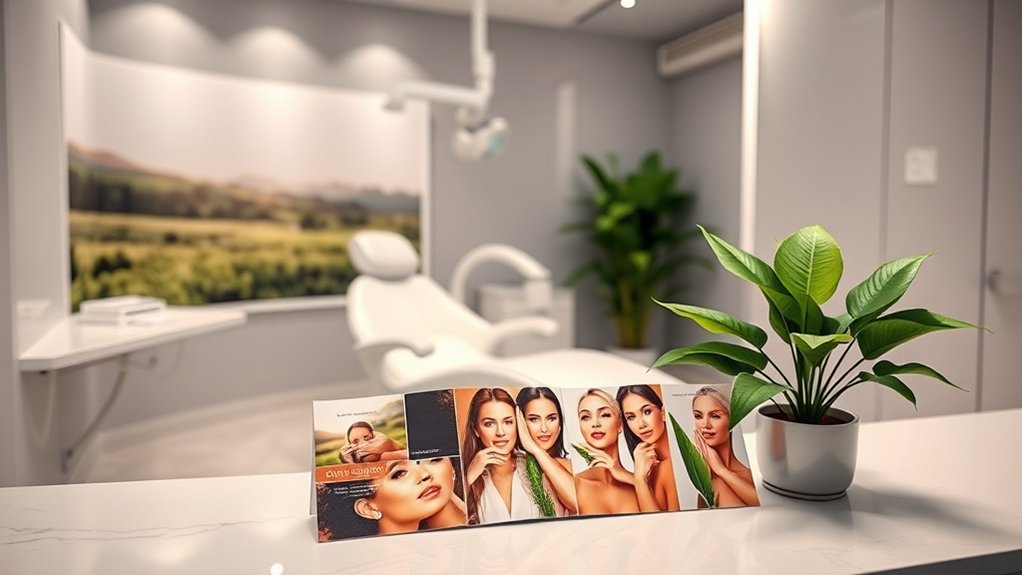You’ll need a strategic SEO approach to capture the 73% of patients researching non-surgical procedures online before booking. Focus on high-intent keywords, optimize your Google Business Profile to convert 76% of local searches into visits, and create conversion-focused landing pages that achieve 2-5% conversion rates. Implement local SEO tactics for “near me” searches, showcase before-and-after galleries, and position clear calls-to-action throughout your site. This complete guide reveals the proven tactics that transform search visibility into measurable patient bookings and practice revenue.
Understanding SEO for Non-Surgical Aesthetic Procedures

In today’s digital marketplace, 73% of aesthetic treatment seekers research procedures online before booking a consultation, making SEO a critical revenue driver for non-surgical aesthetic practices.
Your online visibility directly impacts your bottom line when potential clients search for treatments like Botox, fillers, and laser therapy. Effective keyword research identifies high-intent search terms that convert browsers into bookings.
Local SEO tactics, including optimized Google My Business listings, guarantee you’re findable when prospects search “near me.”
High-quality content—procedure descriptions, patient testimonials, and informative FAQs—builds trust while improving search rankings.
Strategic engagement through before-and-after photos and authentic patient experiences signals credibility to both search engines and potential clients.
This multi-faceted approach transforms your website into a patient acquisition engine, delivering measurable ROI through increased consultations and treatment bookings.
Keyword Research and Targeting Strategy for Non-Surgical Treatments
Strategic keyword research forms the foundation of profitable SEO campaigns for non-surgical aesthetic practices, with targeted search terms generating 3-5x higher conversion rates than generic medical keywords.
You’ll need keyword research tools like Google Keyword Planner to identify high-value opportunities for Botox, dermal fillers, and laser treatments. Focus on long-tail keywords addressing patient concerns such as “how long do dermal fillers last?” to improve search visibility.
Your strategy should include:
- Competitor analysis revealing content gaps your practice can dominate
- Local SEO efforts incorporating location-specific terms that connect nearby patients to your services
- Regular content updates on your website addressing emerging non-surgical treatments and procedure innovations
This data-driven approach guarantees you’re targeting search terms that actually convert browsers into booked consultations, maximizing your marketing ROI.
Building Your Non-Surgical Procedures Content Architecture

Your website’s content architecture directly impacts both search rankings and patient conversion rates, with well-structured medical sites achieving 47% higher engagement than those with disorganized navigation.
Organize non-surgical procedures into distinct categories—injectables, laser treatments, skin care—to refine search engine indexing and user experience.
Create dedicated landing pages for each procedure, incorporating relevant keywords and clear calls-to-action that drive conversions.
Implement structured data markup to enable rich snippets, boosting click-through rates by 30%.
Improve pages with engaging multimedia content like before-and-after galleries that demonstrate treatment effectiveness.
Maintain content authority through regular blog posts addressing trending questions about non-surgical procedures.
This strategic content architecture improves SEO practices while generating sustained organic traffic.
Your structured approach transforms browsers into qualified leads, maximizing ROI from digital marketing investments.
On-Page SEO Optimization for Treatment Pages
Your treatment pages must convert organic traffic into consultations, and that starts with strategic on-page SEO elements that satisfy both search algorithms and prospective patients.
Title tags and meta descriptions directly impact your click-through rates from search results—pages with optimized meta elements see CTR improvements of 20-30% on average.
You’ll maximize ROI by integrating treatment-specific keywords naturally throughout your content while influencing visual elements and clear calls-to-action that guide visitors toward booking appointments.
Title Tags and Meta Descriptions
When potential patients search for non-surgical procedures, your title tags and meta descriptions serve as the first impression in search results—and they’ll directly impact whether someone clicks through to your practice or scrolls past to a competitor.
Following SEO best practices means crafting each unique title tag between 50-60 characters with relevant keywords, while your compelling meta description (150-160 characters) should summarize treatment benefits and include a call to action.
To maximize user engagement and search engine results visibility:
- Never duplicate title tags across treatment pages—each procedure deserves its own optimized identity.
- Include powerful CTAs in meta descriptions that prompt immediate action.
- Conduct regular audits to update keywords and promotional offers.
These strategic optimizations transform your organic listings into high-performing patient acquisition tools with measurable ROI.
Treatment-Specific Keyword Integration
Because each non-surgical procedure attracts distinct patient search behaviors, implementing treatment-specific keywords creates targeted pathways that convert high-intent searches into consultations.
You’ll need compelling H1 tags like “Laser Hair Removal in [Location]” to capture local traffic while increasing search visibility.
Integrate long-tail keywords such as “non-surgical nose reshaping” to address specific patient questions that competitors often miss.
Your meta titles and descriptions must include treatment-specific keywords with clear calls-to-action, directly impacting click-through rates.
Each treatment page requires content exceeding 1,000 words, naturally embedding relevant keywords throughout procedure details, benefits, and FAQs.
This all-encompassing approach maximizes SEO effectiveness by matching your content precisely to what prospective patients search for, transforming organic traffic into measurable ROI through booked consultations.
Visual Content and CTAs
Visual content transforms treatment pages from static information repositories into conversion engines that drive measurable patient inquiries. High-quality before-and-after images and infographics boost user engagement while demonstrating procedure effectiveness.
Strategic image optimization through keyword-rich file names and alt text simultaneously improves SEO and accessibility for all visitors.
Your calls to action require precise placement and visual prominence:
- Position CTAs at three critical touchpoints (top, middle, bottom) to capture patients at different decision stages
- Influence video content featuring procedure demonstrations and patient testimonials to increase time on-site and conversion rates
- Design CTAs with contrasting colors and larger fonts to maximize click-through rates and guide booking consultations
This data-driven approach to visual content and CTAs directly impacts your bottom line by converting casual browsers into scheduled consultations through optimized treatment pages.
Content Marketing Strategy for Non-Surgical Aesthetic Services
As your aesthetic practice competes for visibility in an increasingly digital marketplace, content marketing serves as the foundation for attracting qualified patients actively searching for non-surgical solutions.
Your content marketing strategy should use informative blog posts covering Botox, fillers, and aesthetic treatments to establish authority while driving organic search rankings. Optimize each piece with long-tail keywords like “non-surgical facelift options” to attract potential clients with high purchase intent and increase website traffic.
Implement before-and-after galleries and tutorial videos to set realistic expectations while building trust. Create downloadable guides on popular non-surgical procedures in exchange for contact information, generating qualified leads for follow-up campaigns.
Regularly incorporate patient testimonials and update content reflecting current techniques to maintain relevance. This systematic approach to SEO for Plastic Surgery practices delivers measurable ROI through sustained visibility and conversion growth.
Local SEO and Conversion Optimization for Non-Surgical Practices

Your Google Business Profile serves as the primary entry point for 76% of local searchers, making its optimization essential for capturing high-intent patients actively seeking non-surgical procedures in your area.
Once you’ve driven qualified traffic through local SEO, you’ll need conversion-focused landing pages with clear calls-to-action that transform visitors into booked consultations—typically yielding conversion rates between 2-5% for aesthetic practices.
Strategic placement of patient testimonials, procedure-specific content, and simplifyd booking options directly impacts your cost-per-acquisition and overall marketing ROI.
Optimize Google Business Profile
Local search dominance begins with a fully optimized Google Business Profile, which drives 76% of local mobile searches to result in physical visits within 24 hours.
To optimize your plastic surgery practice’s visibility, you’ll need accurate business information consistent across all online platforms—name, address, and phone number discrepancies kill credibility and rankings.
Transform your profile into a conversion machine through:
- High-quality images showcasing before-and-after results that make prospects envision their transformation
- Positive reviews from satisfied patients that build trust and influence 93% of consumer decisions
- Google Posts announcing promotions and procedure innovations that engage potential clients
This strategic approach doesn’t just improve local SEO—it converts browsers into booked consultations.
Your optimized profile becomes your most powerful local search asset.
Convert Website Visitors Effectively
While attracting local traffic matters, 68% of website visitors leave without taking action—which means your practice needs conversion optimization as much as it needs visibility.
Your local SEO strategies must work alongside tactics that convert visitors into booked appointments. Start by placing clear calls to action throughout your website content, especially sticky booking buttons that follow users as they browse non-surgical procedures.
High-quality content about treatments establishes trust and authority, but patient testimonials and before-and-after galleries create emotional connections that drive decisions.
These elements transform website traffic into revenue by addressing concerns prospects have before choosing your practice. Each service page should guide visitors toward one goal: scheduling a consultation, turning your optimized visibility into measurable ROI.

